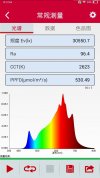The article ays the equipment, is not accurate enough to test above 800nm, but says, not enough study has been done to determine effects above that range.
The effects and potential economic benefits of near-infrared radiation – optical radiation with wavelengths longer than 800 nm – have yet to be explored.
Look at any textbook on botany and you will find this maxim: plants respond to optical radiation in the spectral range of 280 nm to 800 nm.The question is, how was this spectral range (sometimes referred to as Photobiologically Active Radiation, or PBAR) determined?
The Effect of Near-Infrared Radiation on Plants
Ian Ashdown, Senior Scientist | SunTracker Technologies
05/25/22, 05:34 AM |
Indoor & Vertical Farming |
LED
This question addresses issues beyond mere academic curiosity. Recent studies, both in the laboratory and in the field, have shown that ultraviolet-C radiation – optical radiation with wavelengths shorter than 280 nm – offers significant economic benefits for horticultural applications. The effects and potential economic benefits of near-infrared radiation – optical radiation with wavelengths longer than 800 nm – have yet to be explored.
Far-red and the Phytochromes
To understand why 800 nm was chosen, we first need to look at the
phytochromes, a class of photoreceptors that control numerous functions in higher plants, including seed germination, shade avoidance, photomorphogenesis, stem elongation, branching, circadian rhythms, root growth, and flowering times (e.g., Smith 2000 and Wang et al. 2015).
A phytochrome molecule has two isoforms, or states. Its ground state, designated
Pr, preferentially absorbs red light with a peak spectral absorptance at approximately 660 nm. Upon absorbing a red photon, the molecule undergoes a conformational change to become the Pfr isoform. Left in the dark, this isoform will eventually revert to the Pr ground state. However, the molecule will also revert to the ground state if it absorbs a far-red photon with a peak spectral absorptance at approximately 725 nm.
The Pfr isoform regulates physiological changes in plants, and so it represents the biologically active form of phytochrome. It is, in other words, a biological switch. The relative concentration of Pr to Pfr will depend on the ratio of red to far-red light (expressed as R:FR) incident upon the plant leaves, and the plant will respond accordingly (although often in a species-specific manner).
FIG. 2 – Phytochrome spectral absorptances (from Sager et al. 198 .
.
The role of red and far-red light (which is nowadays defined by ASABE 2017 as the spectral region of 700 nm to 800 nm) was discovered by Borthwick et al. (1952). They determined that red light in the region of 525 nm to 700 nm promoted the germination of lettuce seeds (
Lactuca sativa L.) with a peak spectral response at 660 nm, while far-red light in the region of 700 nm to 820 nm inhibited germination, with a peak spectral response of roughly 720 nm.
The spectral absorptances of Pr and Pfr were measured
in vitro by Butler et al. (1964), Gardner and Graceffo (1982), and Sager et al. (198

, with moderately similar results. Today, the high-resolution (2 nm) dataset of Sager et al. is most commonly referenced.
Of note however is the spectral limit for these datasets: 800 nm. Visible light spectroradiometers typically have a spectral range of 350 nm to 800 nm. Wider spectral ranges are possible, but at the cost of reduced spectral resolution. Thus, while near-infrared spectroradiometers are available, they typically have spectral ranges on the order of 650 nm to 1100 nm. The decision therefore to define 800 nm as the limit of PBAR may have been dependent in part on the limitations of laboratory equipment.
Jury is still out, because almost no studies have been done.
My argument is?? The SUN has these light waves, and the plants evolved under these conditions, and anything less than the widest spectrum possible, is not a good example of a light used for growing plants. Sure, they work, but, are not optimal, and come nowhere near the spectrum of the sun.
Look at any textbook on botany and you will find this maxim: plants respond to optical radiation in the spectral range of 280 nm to 800 nm.The question is, how was this spectral range (sometimes referred to as Photobiologically Active Radiation, or PBAR) determined?
www.agritechtomorrow.com













